
|

|
| Chaucers | Elizabethan & Jacobean Frontages |
| Coolings Wine Bar, The Cavern, Vaults & Vines | Gandy Street |
| Pitcher and Piano | Guildhall Shopping Centre |
| Drake's Bar and The Angel | The Rougemont Hotel and Central Station |
| Veuve Bar | Jubilee Court |
| Starz Bar | St Anne's Well Brewery |
| The Tower Inn | The Clock Tower |
| The Mill On The Exe | Exe Island |
| Bishops Blaize | Exe Bridges & Shilhay |
| Use the text links for more information! |
No sidebar menus?, Click Here and re-select |
|
Your meeting place for the start of this historic
crawl is Chaucer's Inn.
This is on the High Street below some perfect examples of Elizabethan and Jacobean buildings, they
are worth a photograph during daylight hours. The reason for the pristine condition of the frontages
is that they are only a facade, and modern buildings extend behind them. They were once however
merchants houses and were for years used as judges lodgings by visiting circuit judges attending
the Exeter Assizes.
Take a look also at Exeter's modern High street, built in the late 1950's. Enter Chaucers Inn through two swinging doors past the swinger standing at the top of the stairs and descend to the main bar down the stairs. The beers aren't bad in here. The food in here used to be very good before the re-fit but I'm not even too sure whether they still serve food during the evening. Again its a good place to meet, very roomy. |
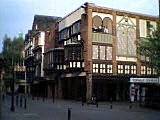
|
Facade
The place was opened in the early 1980's. It was once the storeroom for
C&A, although they didn't know this space existed until one of their employees discovered it one day in the
late seventies about 7 years after they had opened.
He fell through the wall into a black void and had to change his underpants before he returned to work.
Anyway they already had enough storage space so this was sold on to form this pub.
Once you're ready head off down Gandy Street.
Exit Chaucers and turn left and left again down the alley to your left.
|
|
|
|
|
| Exeter Pheonix
Right down the end is upper Paul Street with the stone walls of the museum on the left and C18th brick buildings opposite. Upper Paul Street leads to Exeter Pheonix, the slope up to the building a survivor from the Norman earthworks around the outer ditch of Rougemont Castle. A row of Queen Anne houses known as Bradninch Place stood on the slope together with Bradninch House and a few other houses. These were bought by the University College of the South west (now Exeter University) as it expanded. All however were demolished to make way for the building that now houses the Exeter Pheonix, built between 1909 and 1911. The college grew further and eventually the Streatham Campus was acquired in 1922. Come 1978, the building was used to store reserve library books, however a new use was found as The Royal Albert Memorial School of Art (later the Exeter School of Art). The school remained here until 1972 when it moved to a new building in Earl Richards Road North and became known as Exeter College of Art and Design later being incorporated into Plymouth University. A lottery grant in 1997 enabled the opening of the foyer and addition of a flexible theatre within The Pheonix. Take a look at the pheonix over the entrance. |
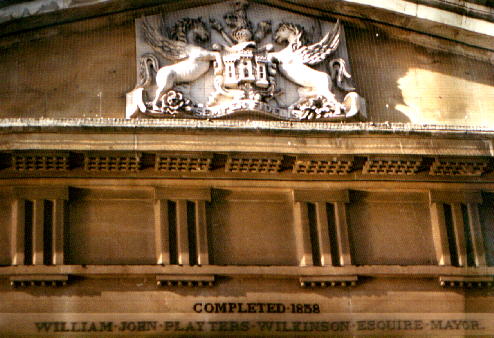 |
Old Post Office Once you've visited some of pubs go through the covered alley into Queen Street which was cut from 1832 to 1835 to give access to the newly erected Higher Market. Little Queen Street was the original short cut to the market before Queen Street was built. The walkway was also once a hive of activity for postal workers. The old post office was once in this alley fronting onto Queen Street (1850-1864). The post office moved to 74 Queen Street (next to Northernhay Gardens) between 1865 and 1885 and then to Eastgate Arcade in 1885. The place was bombed and the post office moved into Bedford Street in 1957. They will move to the former Tesco's building in Sidwell Street when the City Centre is redeveloped in 2003-2007. The original post office in Queen Street still housed postal workers in the 1950's though, possibly for sorting only. |
|
Higher Market In front of you you'll see the columns of the Guildhall Shopping Centre opened in 1976 by HRH Princess Alexandra. The columns represent part of what used to be the old livestock market. This livestock market, then known as Higher Market was first opened in 1691 when the sale of livestock was banned in the High Street. The present construction dates from around 1835. Back in the early seventies it was all boarded up and derelict, having closed in 1962. The picture shows the inscription above the stone columns. |
|
Turn right and walk about 20 yards
to the next pub the Pitcher and Piano
which occupies the site of an old sports shop (John Webber Sports). This was a real
sports shop with sports gear in it and not clothes designed for the people who now
frequent this bar.
St Anne's Well brewery also occupied this site from 1890 to 1966. See the Bygone pub
section for more information. Make Higher Market your selection.
Anyway its not bad inside although I wouldn't care to describe it as anything other than a modern bar. Its heaving on a Friday & Saturday night. The beer is OK. Get them in if you can get to the bar, drink up and head off down Queen Street to the Clock Tower. Queen Street was named after Queen Victoria, a statue was erected on her 29th birthday at the High Street end in 1848, it was made of timber and plaster. A fibre glass replica of this statue is now perched on top of M&S and can barely be seen from street level. The original was not in a good state of repair when it was moved. They don't make things like they used to! |
|
Royal Albert The Royal Albert Museum is on your right as you walk down. This is some building, unfortunately because of the low light in Queen Street I've been unable to get a picture that does it justice. The outer walls are purple Pocombe lava and the inner Heavitree Breccia. The limestone dressings around the windows and edges are limestone from Chudliegh. The window shafts are red sandstone from Taunton. The pillars are Aberdeen granite and the interior marbles are from Ipplepen and Plymouth. Take a look but be careful you don't get arrested. |
| The museum was proposed by Sir Stafford Northcote as a practical memorial to Prince Albert, an appeal was launched in 1861 and the first phases of the Museum were up and running by 1868. The Devon and Exeter Albert Memorial Museum, as it was originally known, provided an integrated museum, art gallery, library, reading room, school of art and school of science in the manner long advocated by the prince. In 1899, York Wing was opened by the Duke and Duchess of York, and at the same time the building was re-named The Royal Albert Memorial Museum. |
The building has changed little since then although the city library
moved out of the Museum in 1930, the school of science ultimately developed
into Exeter University and the school of art is now Exeter Pheonix.
Exeter was once a silver assaying city, using a three towered castle as its hallmark, this castle appears on the City's coat of arms. One gallery inside the museum is devoted entirely to Exeter silver and another to artifacts of the Roman Town of Isca Dummoniorum which became Exeter. |
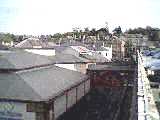
|
Harlequin and Maddock's Row
Over the road on the site that has now become the Harlequin Centre, completed in the mid 1980's was the
Western National Omnibus Company bus station after 1924. The site was cleared of houses in 1921-24 when it was known
as Maddock's Row. The Row comprised a group of C18th houses facing Queen Street with extensive rear gardens running
parallel to the Wall.
The bus company's re-locatoin enabled them to give their passengers good access to the market. Buses lined up against the
city wall which can still be seen behind the Harlequin Centre. There was an information bureau on the corner and
this building had replaced the Museum Hotel. The omnibus company built the office block at the end of Queen Street
in the late 1950's (now occupied by the job centre), previously they had used some of the old hotel buildings.
They moved their whole operation to Paris Street bus station when it opened in 1964. |
| Hotel and Prison
Further down on your right is the Thistle Hotel built in 1875 by the Devon & Exeter Hotel Company
at a cost of 30,000 GBP It was built to cater for the expected passenger traffic from the new London and South Western
Railway which reached Exeter in 1860 and was originally named The Railway Hotel later becoming The Rougemont Hotel. It
was built on the site of the old Felons Prison which opened when the South Gate Prison Closed in 1819.
The County Goal was opened before the Hotel
was built in New North Road to house the prisoners from here and also the debtors
from St Thomas in 1853.
You may wish to drop into Drake's Bar at the side of the
Hotel for a quick pint. Alongside this bar runs Northernhay Street. Towards the bottom of this road are some superb
of C18th housing most of which have been renovated.
|
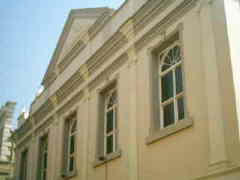
|
The building on the Northernhay Street / Queen Street corner is the old Exeter Dispensary
opened in 1818, there is also a second dispensary further down the road which was a later version of this hospital.
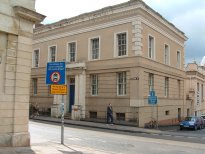 The oldest in the road are on the bottom left. The street also contains Providence Chapel built for the Plymouth Bretheren in the 1860's. It passed to the Bible Christians who gave it a name, then to the Methodists and is now in the hands of the Pentacostal Church. Just below the church is an archway leading to Maddock's Row. The cut in the City Wall was made in 1772. Opposite the Church is the newer version of the Exeter Dispensary, opened in 1843 after the original building had proved to be too small. The place is now an office. |
|
|
Railway
An original London and South Western Railway station was constructed below Northernhay, but the Southern Railway
decided that passengers would be best served by a newer station. Central Station was built in 1933 and
took up the whole of the semi-circular enclosure you'll see further down Queen Street on your right.
Most of the offices and premises were let or sold to business in the 1960's when the line was down
graded. Exeter's main line station was confirmed as Exeter St Davids. Queen Street is straight and
flat having bridged the Longbrook Valley, the platforms are below street level.
Just opposite the station is The Angel, you may want to nip in here for a pint. This place was originally Norton's Confectioners becoming Norton's Hotel and then the Victoria Hotel, Victoria Inn, Garbo's (1985), The Pink Pelican (1989) and most recently Envi until 2001. More information is available in the
Bygone section.
Just a little further on and down a flight of steps is a new addition to Exeter's bar Scene. This
is the Veuve Bar, formerly Bar Bomba (until 2004). More of a wine bar / cocktail bar but worth a
visit. If you had carried on down the steps, you will have arrived at Jubilee Court. This affordable homes development involved the demolition and coversion of two warehouses (costing 2.5mGBP) in August 2002. The development created
new retail outlets and 41 homes and won awards from the Empty Homes Agency.
The building itself has quite a history. It was originally the City Hotel, becoming
Deller' Cafe after WW2. The Dellers Cafe in the High Street was
blitzed and new premises were required. By 1970, the building(s) 44 and 45 Queen Street were offices, becoming Bar
Bomba in 2002. See the Bygone section for more detailed information
|
|
|
|
Clock Tower
Carry on down Queen Street and eventually you'll reach the Clock Tower constructed
as a memorial to William Miles, well known philanthropist and lover
of animals in Victorian times. Nip into the The Tower Inn
on the corner for some much needed refreshment. This pub was once the Osborne Hotel.
It has also been known as O'Neils in the mid nineties and Fermats Number (until 2003) and the Yes Bar. Prior to developing into a pub, it was the Exeter headquarters and social club of the National Farmers Union. The Yes Bar was Exeter's only lap dancing bar until it became The Tower Inn (July 2004).
Incidentally this area of town has developed a reputation for being the City's red light area, though you'd
never know it. We have the classiest hookers in the land. Only £50.00 all in, so I've been told!
Of interest close by is Exeter Prison just along New North
Road on the other side of the Clock Tower. You can be kerb crawling one minute and in jail the next.
Bystock and Queens Terraces were built in the 1840's, the Queens Court Hotel used to be known as
the Bystocks Hotel until 1999 and used to have a pretty good bar, Stocks' Tavern, during the
1980's. Competition from O'Neils (now The Tower Inn) and The Imperial possibly prompted this closure. Bystocks Hotel was
established in 1925.
|
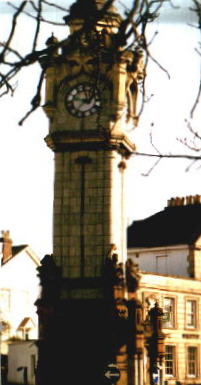 |